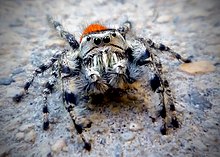| Phidippus adumbratus | |
|---|---|

| |
| Scientific classification | |
| Domain: | Eukaryota |
| Kingdom: | Animalia |
| Phylum: | Arthropoda |
| Subphylum: | Chelicerata |
| Class: | Arachnida |
| Order: | Araneae |
| Infraorder: | Araneomorphae |
| Family: | Salticidae |
| Subfamily: | Salticinae |
| Genus: | Phidippus |
| Species: | P. adumbratus |
| Binomial name | |
| Phidippus adumbratus Gertsch, 1934 | |
Phidippus adumbratus is a species of jumping spider in the family Salticidae. It is found in the United States and Mexico. The type species was collected In Los Angeles and named in 1934. Adumbratus is one of the insignarius group of Phidippus spiders.
Within the United States, Phidippus adumbratus is within the California Floristic Province in native chaparral and in oak-sycamore-chaparral woodland between 500–3,700 ft (150–1,130 m). A spider survey published in 1999 found P. adumbratus present in coastal sage scrub in the vicinity of San Diego. A spider survey report published in 2022 found individuals in Baja California's Central Desert ecoregion in Sierra Blanca, Ensenada Municipality, Mesa Escondido and San Antonio de Las Minas on the Baja California peninsula.
The etymology of the Latin name is from the adjective adumbratus, meaning "secret, in the dark (perhaps alluding to the fact that the abdomen of the holotype is missing, and the describer was 'in the dark' as to its appearance)." According to BugGuide, adumbratus is often used by zoologists to indicate a "hazy dark pattern".

References
- ^ "Phidippus adumbratus Species Information". BugGuide.net. Retrieved 2018-02-06.
- ^ "Phidippus adumbratus Report". Integrated Taxonomic Information System. Retrieved 2018-02-06.
- "Phidippus adumbratus Overview". Encyclopedia of Life. Retrieved 2018-02-06.
- "NMBE World Spider Catalog, Phidippus adumbratus". Retrieved 2018-02-06.
- ^ Hernández Salgado, Luis C.; Guerrero Fuentes, Dariana R.; Garduño Villaseñor, Luz A.; Castañeda Betancur, Lita; López Reyes, Eulogio; Ceccarelli, Fadia Sara (2022-02-24). "New Distributional Records of Phidippus (Araneae: Salticidae) for Baja California and Mexico: An Integrative Approach". Diversity. 14 (3): 159. doi:10.3390/d14030159. ISSN 1424-2818.
- Gertsch, Willis John (1934). "Further notes on American spiders" (PDF). American Museum Novitates (726). New York City: American Museum of Natural History.
- ^ Edwards, G.B. (2004). "REVISION OF THE JUMPING SPIDERS OF THE GENUS PHIDIPPUS (ARANEAE: SALTICIDAE)". Florida State Collection of Arthropods FDACS, Division of Plant Industry Bureau of Entomology, Nematology, and Plant Pathology. Occasional Papers of the Florida State Collection of Arthropods. 11: 47–48. Retrieved 2023-01-16 – via ResearchGate.net.
- Prentice, Thomas R.; Burger, Jutta C.; Icenogle, Wendell R.; Redak, Richard A. (1999). "Spiders from Diegan coastal sage scrub (Arachnida: Araneae)". Pan-Pacific Entomologist. 74 (4): 181–202.
Further reading
- Ubick, Darrell (2005). Spiders of North America: An Identification Manual. American Arachnological Society.
- Dean DA (2016). "Catalogue of Texas spiders". ZooKeys (570): 1–703. doi:10.3897/zookeys.570.6095. PMC 4829797. PMID 27103878.
- Maddison WP, Evans SC, Hamilton CA, Bond JE, Lemmon AR, Lemmon EM (2017). "A genome-wide phylogeny of jumping spiders (Araneae, Salticidae), using anchored hybrid enrichment". ZooKeys (695): 89–101. doi:10.3897/zookeys.695.13852. PMC 5673835. PMID 29134008.
| Taxon identifiers | |
|---|---|
| Phidippus adumbratus | |
This article related to jumping spiders (Salticidae) is a stub. You can help Misplaced Pages by expanding it. |